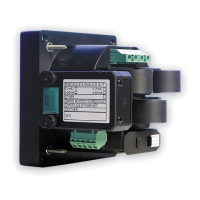18
Table 5-11 Setpoints Status
Bit Description
0 Setpoint # 1 status
1 Setpoint # 2 status
2 Setpoint # 3 status
3 Setpoint # 4 status
4 Setpoint # 5 status
5 Setpoint # 6 status
6 Setpoint # 7 status
7 Setpoint # 8 status
8 Setpoint # 9 status
9 Setpoint # 10 status
10 Setpoint # 11 status
11 Setpoint # 12 status
12 Setpoint # 13 status
13 Setpoint # 14 status
14 Setpoint # 15 status
15 Setpoint # 16 status
Bit meaning: 0 = setpoint is released, 1 = setpoint is operated
Table 5-12 Log Status
Bit Description
0 Reserved
1 New Min/Max Log
2-15 Not used (permanently set to 0)
Bit meaning: 0 = no new logs, 1 = new log recorded (the new log flag is reset when the user reads the first log record
after the flag has been set)
Table 5-13 Setpoint Alarm Status
Bit Description
0 Alarm #1
1 Alarm #2
2 Alarm #3
3 Alarm #4
4 Alarm #5
5 Alarm #6
6 Alarm #7
7 Alarm #8
8 Alarm #9
9 Alarm #10
10 Alarm #11
11 Alarm #12
12 Alarm #13
13 Alarm #14
14 Alarm #15
15 Alarm #16
Bit meaning: 1 = setpoint has been operated
The setpoint alarm register stores the status of the operated setpoints by setting the appropriate bits to 1.
The alarm status bits can be reset all together by writing zero to the setpoint alarm register. It is possible to
reset each alarm status bit separately by writing back the contents of the alarm register with a
corresponding alarm bit set to 0.
Table 5-14 Self-check Alarm Status
Bit Description
0 Reserved
1 ROM error
2 RAM error

